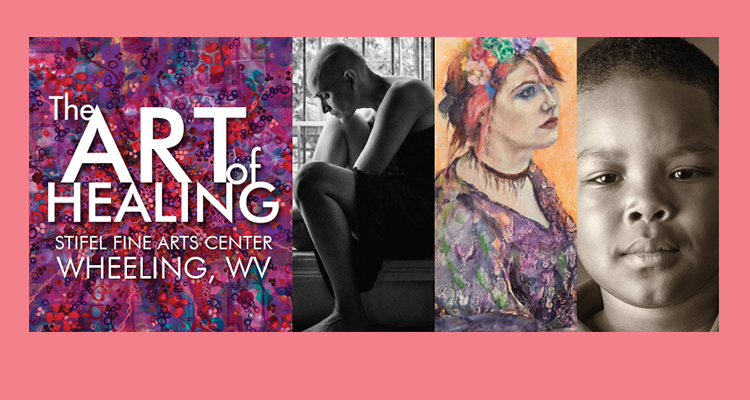When Angelo Merendino’s wife Jennifer was diagnosed with breast cancer at the age of 36, he documented her battle through photographs to raise awareness about the day-to-day struggles they faced.
When Angela Canada Hopkins’ father died from cancer, she embraced this new “enemy” through art. She began painting the disease by deconstructing microscope slides of cancer cells and reinterpreting them on canvas.
Shawn Thornton’s brain cancer caused him to have hallucinatory visions, which he expressed in his art. His paintings became a kind of visual diary, depicting the elements he saw.
Merendino, Hopkins and Thornton are among the artists featured in “The Art of Healing,” a new exhibit at Oglebay Institute’s Stifel Fine Arts Center that explores the therapeutic power of the creative process to address the physical, emotional and spiritual needs of cancer patients and their loved ones.
The exhibit also includes Narrative Medicine panels by creative writer Renée K. Nicholson along with drawings of the late Lacie Wallace, created by the Stifel Fine Arts Center’s figure drawing group as she battled cancer. The Bodice Project — a collection of abstract torso sculptures — is also featured. Portraits of children battling cancer, created by Keith Berr for the Flashes of Hope project, will also be on display.
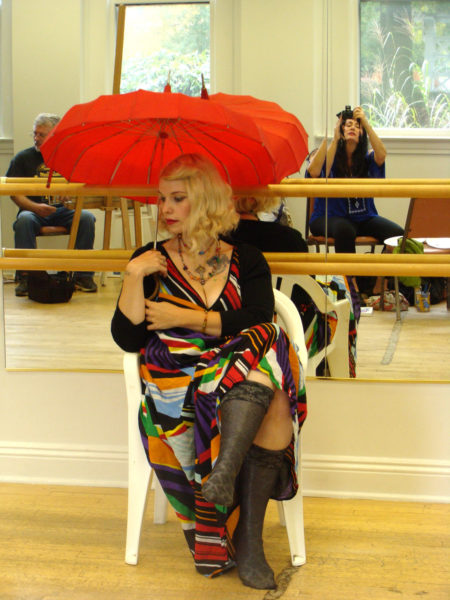
Through drawing, painting, photography, sculpture and written word, artists chronicle their journeys from a variety of perspectives and offer powerful visual portrayals of the emotional impact associated with a physical illness.
Curated by Michael McKowen, “The Art of Healing” is on display from Thursday, Feb. 28, through Friday, April 19. A lecture series takes place in conjunction with the exhibit. Programs explore using art in the healing process and provide resources and social support for those affected by cancer. Programs take place at 6 p.m. every Thursday from March 7 through April 18.
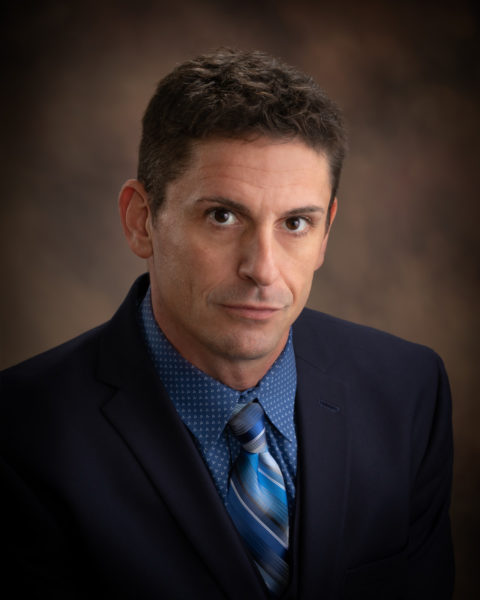
“The Art of Healing” is sponsored by The Health Plan, WVU Medicine and United Bank with additional support provided by the Home Support Foundation.
HOW ART CAN HEAL
Cancer is a physical illness, but the disease has emotional and psychological consequences. Art can help people cope.
“Mainly, it allows them to express emotions that are often difficult to communicate in words,” curator McKowen explained.
For some, it provides an escape from treatment anxiety and fears of the future. Others find that it relieves depression and feelings of social isolation. It can often reduce physical pain. Art can be an outlet for people to share their stories with others and raise awareness about the struggles of those affected by cancer. It can also provide a sense of control in situations filled with uncertainty.
CREATING POSITIVE ENERGY
For McKowen, art therapy is about creating positive energy.
He has always been fascinated with the concept of energy. His curiosity piqued through studying yoga. “Yoga teaches people how to direct energy through the body.” Similarly, artists move energy through the body and pass it on to the work they are creating, he explained.
“Sometimes we can’t control what happens to our bodies. The only thing we can do is shape the energy. We can use creative visualization to help battle illness.”
AESTHETICALLY PLEASING, EMOTIONALLY POWERFUL
Aesthetically, “The Art of Healing” is “a visually stunning experience,” McKowen said. “The pieces in the show and the artists featured are extremely strong. It is an incredible experience just on that level.”
The exhibit also reflects the range of emotions felt by those dealing with cancer — from love, courage and hope to anger, fear and grief and everything in between.
McKowen said people will have “powerful emotional responses” to many of the pieces in the show.
TACKLING A DIFFICULT SUBJECT MATTER
He acknowledges some of the pieces may be difficult to view. For example, Merendino’s photos reflect the harsh realities of breast cancer. The photos are grippingly raw. Nothing is sugar-coated. For the Merendinos, that was the point. They wanted to bring attention to the realities of daily life with cancer.
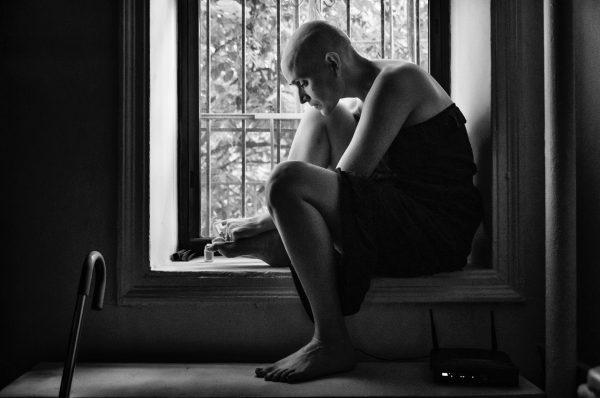
“One of the great things about art is that it can be raw emotion. It can be unfiltered, uncensored, “ McKowen said. “Unless we are willing to see something for what it really is, we might never really understand it.”
The Flashes of Hope project captures precious moments in time by creating portraits of children battling cancer. The organization honors the courage of those children and raises funds to accelerate a cure for childhood cancers.
“It is very difficult because you are looking at children that may not survive. But what makes that work so strong is that in those images, you don’t sense that. You see life. You see hope.” McKowen said.
COLOR, SHAPE AND TEXTURE
McKowen seeks to include various mediums, perspectives and stimuli in the exhibits he curates. In this show, he complements the realism in the photography elements by incorporating colorful, abstract and three-dimensional pieces into the show.
“We want to move people in different ways,” he said.
Enter The Bodice Project, Angela Canada Hopkins and Shawn Thornton.
The Bodice Project features uplifting sculptures that focus on the strength and beauty of individuals who have had breast cancer.
“The project started out with just literal castings of torsos and evolved into abstract sculptures that are representative of torsos, still all communicating this search for understanding and this sharing of experiences, particular with breast cancer.”
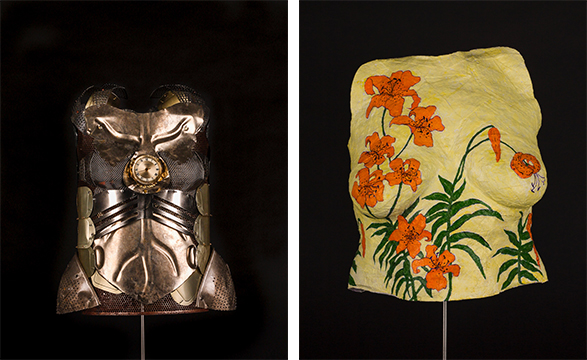
Science and art intersect in Hopkins’ vibrant, abstract paintings of cancer cells. McKowen describes her pieces as “flourishing in beauty like beds of glowing positive energy.”
Thornton’s mystical paintings were created when he was suffering from undiagnosed cancer of the pineal gland. His imagery is infused with mythology and symbolism and is reminiscent of hallucinations.
“Shawn didn’t understand what was going on inside him and nobody around him knew what was going on, so he just released all of it into his paintings.”
NARRATIVE MEDICINE: TREATING THE WHOLE PERSON
Another interesting aspect of “The Art of Healing” is Renée Nicholson’s work in Narrative Medicine — a medical approach that utilizes patients’ individual life stories to improve treatment experiences. The approach allows doctors to enhance care, beyond managing symptoms, and facilitates patients’ abilities to cope with the illness.
She worked with Wheeling native and figure study model Lacie Wallace. The exhibit features a collection of drawings and paintings of Wallace created by figure study artists.
“All these artists, maybe not consciously aware at the time, were documenting Lacie’s physical changes as she was battling cancer. They were all emotionally connected to Lacie. This opened up a whole other aspect of the exhibit as they reflected on what they went through during this process.”
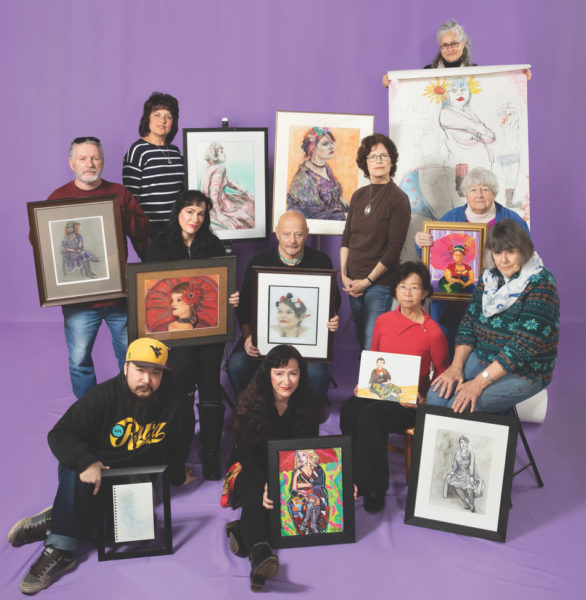
LEARNING, UNDERSTANDING AND CONNECTING
McKowen said “The Art of Healing” is about more than the art; it’s about interaction, dialogue and illuminating our shared humanity.
The weekly lecture series that complements the exhibit will provide information on a variety of topics for people affected by cancer, raise awareness about the benefits of art therapy and allow people to connect with one another.
“You have a chance to listen to other people’s stories. Being able to share what is happening with you with someone else who has similar experiences changes everything. It feels like a weight is removed when you are able to connect with other people.”
LOVE AND THERAPY
In this exhibit, the concepts of therapy and love are interwoven, McKowen explained. “Every piece you see in this exhibit is a form of therapy, ways people are healing something within themselves. And, really that is just a form of love, whether it’s love for someone else, love of yourself or love for life in general. It all comes down to love.”
• THE ART OF HEALING LECTURE SERIES •
Join Oglebay Institute for a series of learning and community-building events held at Oglebay Institute’s Stifel Fine Arts Center in conjunction with “The Art of Healing” exhibit. Programs explore using art in the healing process and provide resources and social support for those affected by cancer. Special guests include artists featured in “The Art of Healing,” oncology experts, social workers, art therapists and cancer patients and their families.
Programs take place at 6 p.m. every Thursday from March 7 through April 18 and are free and open to the public. Light refreshments will be served.
• Thursday, March 7: Angelo Merendino
Photographer Angelo Merendino will discuss his photo-documentary “The Battle We Didn’t Choose — My Wife’s Fight with Breast Cancer.” Intimate, honest and moving, Merendino’s photographs offer a look inside the day-to-day life of a young couple facing breast cancer together.
• Thursday, March 14: “The Face of Cancer” Photo Presentation
Fine art photographer and cancer survivor Pete Wildey sheds a positive light on a negative subject. “The Face of Cancer” is a powerful portrait series coupled with a positive narrative that will change the way you view cancer patients, and perhaps, even your own lifestyle. Wildey will discuss the stories behind the portraits and this very personal project.
• Thursday, March 21: Reneé K. Nicholson
Creative writer Renée K. Nicholson will discuss her work with Narrative Medicine — a medical approach that utilizes patients’ individual life stories to improve treatment experiences. The approach allows doctors to enhance care, beyond managing symptoms and facilitates patients’ abilities to cope with the illness. Nicholson will share her experience working with Wheeling native and Stifel Fine Arts Center figure model Lacie Wallace.
• Thursday, March 28: Art Therapy Panel
A panel of art therapists will discuss the healing benefits of using art to cope with illness such as expressing emotions that are difficult to verbalize, providing an escape from treatment anxiety and fears of the future, alleviating pain and discomfort, relieving depression and feelings of isolation, and adjusting to a changing body image.
• Thursday, April 4: Exploring Your Inner Landscape: Yoga & Sound Bath
Chelsey Keding weaves musical gift with energy medicine in a way that can sooth to the core. She’ll guide us to find our own voice’s therapeutic value, then play a worldly variety of healing instruments, while Lindsay Schooler (E-RYT) guides folks through introspective visualization alongside a range of movement and periods of stillness with great purpose and care. Class closes with an extended sound bath, as Chelsey creates soothing sound through quartz singing bowls, tuning forks, a Shruti box, and her own wonderful voice. All levels. All are welcome.
• Thursday, April 11: The Bodice Project Artists
Get an in-depth look at “The Bodice Project” from the artists who created this uplifting and sensitive sculptural exhibit that focuses on breast cancer, inner healing and awareness. Breast cancer survivors will join the artists for a panel discussion about emotional healing and life after treatment.
• Thursday, April 18: Lacie Wallace Benefit Auction
Presented by the Independent Artist Group, this special auction will feature pieces done of Lacie Wallace during modeling sessions over a two-year period and throughout her battle with colon cancer. Proceeds will benefit the education funds of Lacie’s two daughters, Rozzalin and Zuzu.
• Misty Klug is director of marketing and communication for Oglebay Institute. An advocate for the arts, board game geek and wannabe comedian, she questions everything and always roots for the underdog. She lives in Shadyside with her husband Joe and their dogs — Norman and Lucy. Now empty nesters, their passions include renovating homes, traveling, engaging with old and new friends, and porch sitting.


